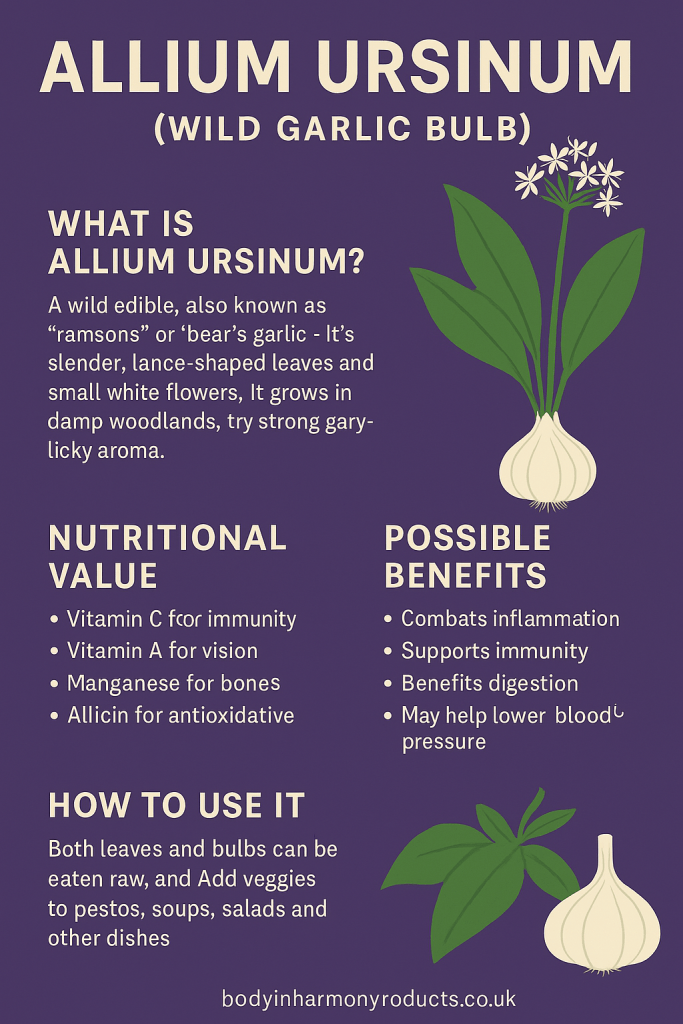Allium Ursinum: Nature’s Wild Remedy for Body and Plate
Allium ursinum, more commonly known as wild garlic, ramps, or bear’s garlic, is one of nature’s most underrated plants. Found carpeting shady woodland floors each spring, this pungent green wonder is more than just a forager’s delight — it’s a natural powerhouse for your health.
If you’ve ever stumbled across a forest that smelled faintly of garlic, chances are, you’ve already met it.
What Actually Is Allium Ursinum?
Allium ursinum is a wild cousin of regular garlic. It’s native to Europe and parts of Asia and is known for its vibrant green leaves and small white star-shaped flowers. Unlike the garlic bulbs we’re used to, the leaves, stems, and flowers are what get harvested here.
What makes this plant stand out isn’t just its unmistakable aroma — it’s also its health-boosting compounds. Packed with allicin, sulphur, and other beneficial phytochemicals, it’s been used in traditional medicine for centuries.
Why It’s Gaining Popularity Again
More people are turning to allium ursinum for its naturally cleansing and circulatory-supporting effects. Although it’s long been a staple in European herbalism, its benefits are now gaining traction in wellness circles globally.
You’ll often find it dried, powdered, or turned into oils and extracts. But if you’re lucky enough to get it fresh — even better.
Benefits of Allium Ursinum for the Body
🌿 Supports Healthy Circulation
Wild garlic has long been associated with heart health. Its natural compounds, especially allicin, help widen blood vessels and support better blood flow. This makes it especially useful for those concerned about high blood pressure or sluggish circulation.
🌿 A Natural Detoxifier
The sulphur compounds in allium ursinum help stimulate liver function and promote detoxification. For those seeking a natural cleanse, this wild green is a perfect companion to leafy greens and herbal teas.
🌿 Boosts Immunity and Fights Inflammation
Rich in antioxidants and natural antibacterial properties, wild garlic may support the immune system while calming low-level inflammation. If you’re feeling run-down or prone to frequent sniffles, adding this to your diet could help.
🌿 May Help Lower Cholesterol
Early research suggests that compounds in wild garlic may help reduce bad cholesterol (LDL) while supporting the good kind (HDL). While more studies are needed, the plant’s traditional use for cardiovascular support gives it some credibility.
How to Use Wild Garlic Safely
Whether you forage or buy it, make sure you’re using allium ursinum and not a lookalike. Lily of the valley, for example, is toxic and sometimes grows nearby. Always go by scent — wild garlic has a strong, unmistakable garlicky aroma.
Use the leaves fresh in pesto, salads, or soups. You can also dry them for year-round use. The flavour is less intense than traditional garlic, with a fresh, green undertone.
-
Add to omelettes or stir-fries
-
Blend into green juices
-
Make a wild garlic butter
-
Infuse into oils for cooking
A Plant with Historical Roots
The name “ursinum” comes from the Latin word for bear — it’s said that bears seek out wild garlic after hibernation to cleanse and reawaken their bodies. This might explain why it’s so invigorating for us too.
Traditionally used across the British Isles and Europe for digestive issues, skin conditions, and fatigue, it’s remained a folk favourite for centuries.
Final Thoughts: Should You Try Allium Ursinum?
Absolutely — especially if you’re someone who prefers natural approaches to health and wellbeing.
Allium ursinum is one of the best wild edibles you can add to your wellness routine. It’s gentle, cleansing, heart-supportive, and easy to incorporate into food. Whether you’re foraging in the woods or picking up dried leaves from a specialist shop, it’s a green worth going after.
And let’s not forget the taste — fresh, aromatic, and unlike anything in the supermarket aisles. Curious about other wild greens? Don’t miss our post on nettle tea benefits for skin — a natural way to nourish your body from the inside out.






